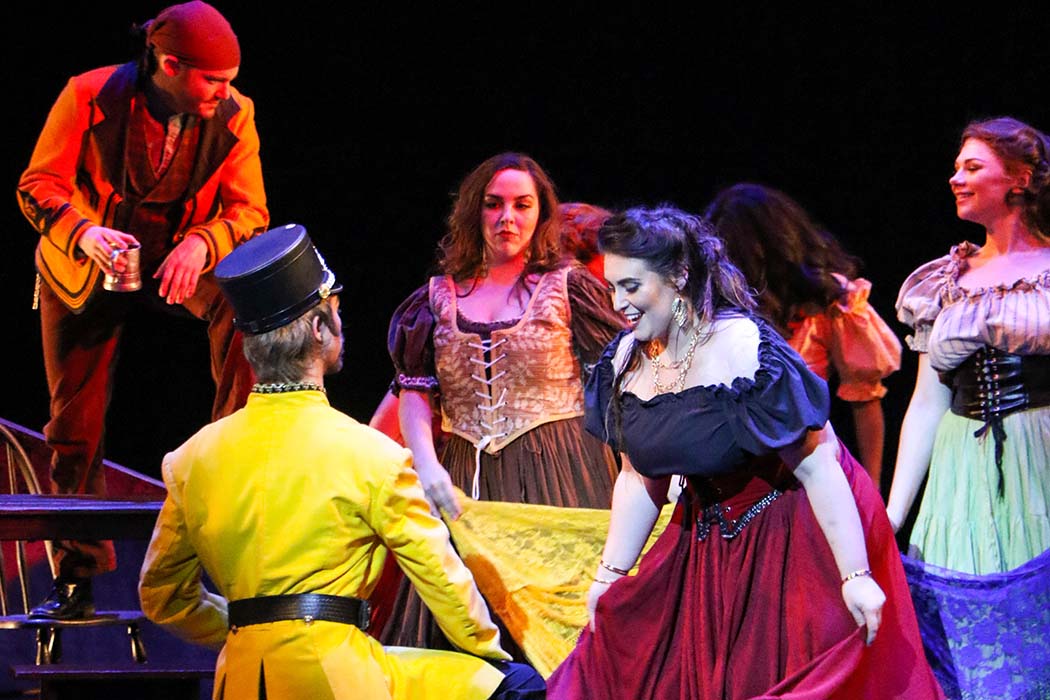Performances in this review—
Saturday evening, April 12, and Sunday afternoon, April 13
Georges Bizet never knew of the worldwide success that his Carmen would eventually attain, dying a young man of 36 but three months after the work’s premiere at Paris’ Opéra-Comique in 1875. Contending with ill health, Bizet had fought with almost everyone over that first production, including with the company’s directors, many of the musicians, and with a Paris audience that was, ironically, shocked by the characters’ lack of morality. While Parisians may have been initially unimpressed by Carmen, elsewhere the work was adored by audiences and singers, including the original Carmen, mezzo-soprano Célestine Galli-Marié, and by surprising far-flung supporters such as Friedrich Nietzsche. Today, it is listed as the #2 most-performed opera in the world after Verdi’s La Traviata.
Carmen proved to be immensely popular last weekend, as well, with the University of Tennessee Opera Theatre’s audience at the Bijou, a production that had four performances with multiple casts. In addition to Bizet’s extremely tuneful score, the opera’s popularity also stems from a relatively uncomplicated plot and fluid libretto written by Henri Meilhac and Ludovic Halévy, based on the novella by Prosper Mérimée. Set in Seville, it tells the story of Carmen, a gypsy smuggler, who seduces an army corporal, Don José, and convinces him to abandon his fiancée and turn to crime. Inevitably, Carmen grows tired of Don José and rejects him for the flashy, swaggering, and handsome toreador, Escamillo. Confronting Carmen outside the bullring where Escamillo is fighting the bulls, Don José realizes the futility of his obsession with Carmen and stabs her to death as the curtain falls.
UTOT’s Carmen, led by production director James Marvel, was defined by a relatively simple visual approach of tarot card metaphors and suggestive abstractions that used minimal hanging set pieces that were given mood, meaning, and location by lighting and projections—all of which provided an open staging environment for the singers and chorus. Music director and conductor Kevin Class led a reduced ensemble, but one perfectly sized for the Bijou Theatre orchestra pit and acoustics.

The four performances of Carmen saw mostly double casting, with three roles (Frasquita, Mercédés, and Don José) triple cast. In the title role of Carmen were Sarah Beegle and Tori Franklin, two excellent singers offering two contrasting voice timbres and vocal approaches. Beegle’s voice, falling lusciously somewhere in between contralto and mezzo, was rich and mysteriously intriguing. Franklin, a definite mezzo, had that low end strength as well, and the ability to turn her upper range into a theatrical dagger. Dramatically, both were equally impressive, able to play the dominant personality of Carmen physically, as both seductive and heartless as the moment demanded. Both were terrific in the famous “Habanera”.
In the role of Don José were tenors Wayd Odle and Boris Van Druff (I did not see the performance sung by Lee Brandt). Van Druff, a former UT School of Music grad student who was recently seen and heard as an Apprentice Artist with Sarasota Opera, sang the role of Don José with a striking clarity supported by an engaging strength and depth of vocal character. This vocal performance complemented his portrayal as a well-meaning, but naive and hapless victim in the face of Carmen’s seductive power. Odle’s Don José, too, found himself the victim of Carmen, but perhaps in a more complicated and willing fashion. Vocally, Odle sang the role with impressive strength and attractiveness, as was evidenced by a haunting Flower Song (“La fleur que tu m’avais jetée”) in Act II.

Also returning to UTOT was UTKSOM alum Peter Johnson in the baritone role of the toreador, Escamillo. Johnson’s experience and stage presence were winning qualities that supported a strong vocal performance in his fabulous take on one of opera’s most recognized arias, the Toreador Song (“Votre toast je peux vous le rendre”). The evening cast Escamillo was bass-baritone Derek Stull, a substantial singer that brought his own dramatic swagger and attitude to a performance oozing with energy.
The lovely, but unfortunate fiancée of Don José, Micaëla, was sung by Madeline Hamrick and Emily Johnson in the performances I attended. Of course, Micaëla has the charmingly sweet but anxious aria in Act III, “Je dis que rien ne m’épouvante”, handled beautifully with lightness and poignance by both Johnson and Hamrick.
In the matinee cast, the roles of Frasquita and Mercédés, Carmen’s fellow gypsies in crime, were sung and portrayed with wit and visual impact by Kathryn Shepas and Hannah Friend, respectively. Although secondary vocally to Carmen, the roles are essential for the flavor and substance of the crowd scenes and demand physicality and insight into the subtext of the opera. In the evening cast, Elizabeth Stovall and Anna Young were seen as the excellent notable pair, with their own take on gypsy badness.
Appearing in all performances as the army lieutenant, Zuniga, and giving the comeuppance role a notable presence and style, was Logan Campbell.
As we have come to expect from Marvel’s staging, the chorus movement was intriguing and well-designed, giving substance to the stage picture. On several occasions, he used slow-motion movement as symbolic gestures of time spent and distance traveled, a captivating spin on the narrative line—and a cunningly creative transition.
Following Marvel’s lead were the production’s designers, who gave the opera its visual substance: Helen Garcia-Alton, lighting designer; Chandler Oppenheimer, projection designer; Becca Johnson, scenic designer; and Glenn Avery Breed, costume designer.
Following up on the excellent outing last fall with Mozart’s The Secret Gardener, the UT Opera Orchestra again impressed with solid playing and pit stamina under Kevin Class’ sparkling pacing.






